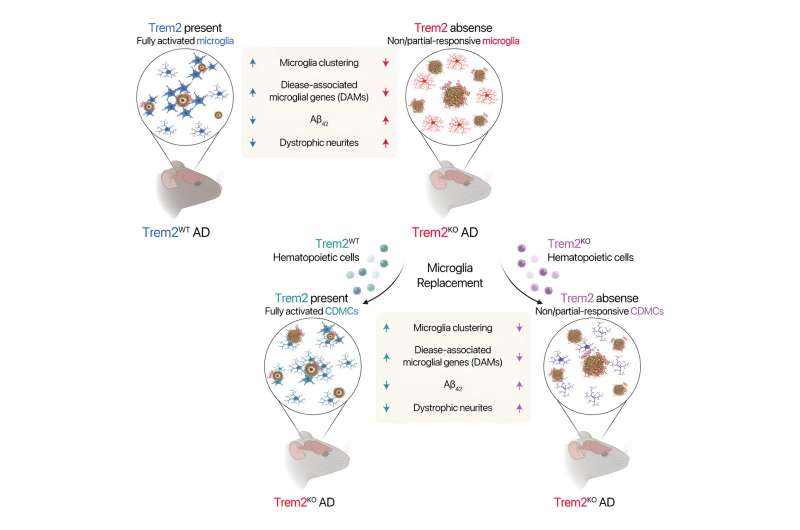This article has been reviewed according to Science X's editorial process and policies. Editors have highlighted the following attributes while ensuring the content's credibility:
fact-checked
peer-reviewed publication
trusted source
proofread
Researchers find success with stem cell therapy in mice model of Alzheimer's disease

Stanford Medicine researchers are hopeful that a proof-of-concept treatment in mice—blood stem cell transplants—may reduce signs of Alzheimer's disease.
The team of scientists, led by Marius Wernig, MD, Ph.D., a professor of pathology and a researcher at the Stanford Institute for Stem Cell Biology and Regenerative Medicine, transplanted blood stem and progenitor cells into mice, effectively leading to the replacement of a type of neural cell, called microglia, that's defective in mice with the disease.
"This cell therapy approach is unique in the field because most researchers are working to find pills or injectables to treat Alzheimer's disease," Wernig said.
The results were published in August in the journal Cell Stem Cell. Wernig is the senior author on the paper, and postdoctoral scholar Yongjin Yoo is lead author.
Despite extensive research on Alzheimer's, what causes the neurodegenerative disorder and how it develops are not well understood. Most therapies focus on clearing the buildup of amyloid plaques found in the brains of people with Alzheimer's disease, though it is not clear if these plaques are merely a sign of Alzheimer's pathology or are directly causing dementia.
There is, however, a clear association between nonfamilial Alzheimer's disease, which tends to strike later in life and does not stem from an inherited gene variant, and various mutations in microglia. Microglia cells protect other brain cells against invaders and function as a cleanup crew, taking out the metabolic trash that can accumulate in the brain.
Scientists have observed that some genetic variations in microglia show a strong correlation with an increased risk of Alzheimer's disease. One such correlation involves a gene called TREM2, which plays an essential role in in how microglia detect and address neurodegeneration. "Certain genetic variants of TREM2 are among the strongest genetic risk factors for Alzheimer's disease," Wernig said.
"The data are convincing that microglial dysfunction can cause neurodegeneration in the brain, so it makes sense that restoring defective microglial function might be a way to fight neurodegeneration in Alzheimer's disease," he added.
TREM2 transplant
In the study, mice with a defective TREM2 gene received hematopoietic stem and progenitor cell transplants from mice with normal TREM2 function. The researchers found that the transplanted cells reconstituted the blood system and that some of them efficiently incorporated into the recipients' brains and became cells that looked and behaved like microglia.
"We showed that most of the brain's original microglia were replaced by healthy cells, which led to a restoration of normal TREM2 activity," Wernig said.
Next, they investigated whether the restored TREM2 activity was enough to improve the brain health of the TREM2-deficient mice. "Indeed, in the transplanted mice we saw a clear reduction in the deposits of amyloid plaques normally seen TREM2-deficient mice," Wernig said. They were also able to show a restoration of microglial function and reduction of other disease markers, indicating that functional restoration of this one gene had widespread positive effects.
Wernig and colleagues said they could transplant cells engineered to have supercharged TREM2 activity that may have an even greater effect.
They caution, however, that the microglia that formed from the transplanted cells were slightly different from the natural microglia in mouse brains. "These differences might in some way have their own detrimental effect," Wernig said. "We have to look at that very carefully."
In addition, the current procedure would be highly risky if it were developed for human therapy because transplantation of blood stem cells requires the recipient to undergo a highly toxic chemotherapy or radiation treatment to kill off native blood stem cells.
However, many researchers, including some at the Institute for Stem Cell Biology and Regenerative Medicine, are developing less toxic methods of preconditioning patients for stem cell transplants. A brain cell therapy could then piggyback on such improved and safer transplantation methods.
More information: Yongjin Yoo et al, A cell therapy approach to restore microglial Trem2 function in a mouse model of Alzheimer's disease, Cell Stem Cell (2023). DOI: 10.1016/j.stem.2023.07.006





















